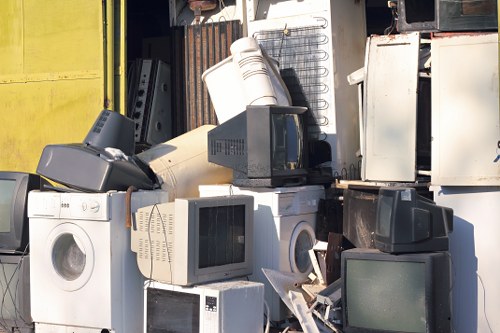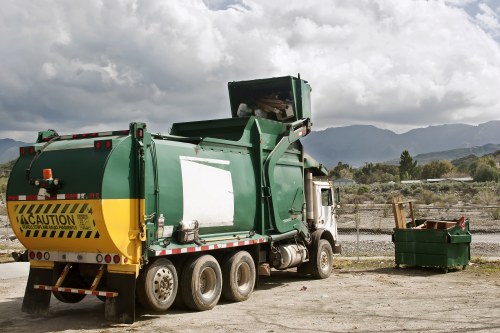Builders Waste Clearance in Office Clear: A Pathway to a Cleaner, Safer Workspace
Introduction to Builders Waste Clearance in Office Clear

In today’s fast-paced business environment, maintaining a clutter-free and efficient workspace is essential. Builders waste clearance in office clear projects is at the forefront of this effort, ensuring that both completed construction projects and office refurbishments leave behind an environment that is as safe as it is inspiring. In recent years, the focus on sustainable and efficient waste removal has increased, with companies recognizing the **importance** of professional clearance services. This not only supports environmental goals but also enhances brand image.
Builders waste clearance refers to the systematic removal of leftover materials such as concrete, wood, metals, and packaging remnants. When performed in office clear scenarios, this process ensures that outdated materials or construction waste from office upgrades do not mix with daily operations. Efficiency and thorough planning are the cornerstones of a quality waste clearance strategy, offering tangible benefits to many organizations aiming to modernize their workspaces.
Office spaces undergoing renovations often have debris that can hinder productivity and safety. Being proactive in managing this waste means significantly reducing hazards, preventing structural damage, and minimizing any potential disruptions. This approach speaks volumes about a company’s commitment to professionalism and responsibility. Implementing effective builders waste clearance is not just a matter of aesthetics; it also incorporates compliance with local waste management laws and sustainability standards.
The Importance of Builders Waste Clearance for Office Environments

Every organization desires a workspace that reflects its values of efficiency and sustainability. Builders waste clearance in office clear projects plays a crucial role in ensuring that remnants of construction or renovation do not detract from these values. The removal of hazardous materials, coupled with the recycling of usable waste, not only facilitates a healthier work environment but also reinforces corporate social responsibility. Institutions are increasingly aware that a clean office promotes better employee morale, creativity, and productivity.
Proper waste clearance is also pivotal in meeting regulatory requirements. Local councils and environmental bodies have strict guidelines on waste disposal, and failure to comply can lead to significant fines or operational delays. Companies benefit when they work with professionals who are up-to-date on the latest codes and practices. This ensures waste is managed in accordance with environmental protocols, protecting your business from potential legal issues.
Moreover, the role of builders waste clearance in maintaining a safe environment cannot be understated. Construction materials, if not properly disposed of, might pose an injury risk to employees. By adhering to a structured clearance plan, companies reduce these risks and create a germ-free and secure space, which is a tangible investment in employee well-being and operational efficiency.
Key Benefits and Cost Savings of Professional Waste Clearance

One of the most compelling reasons to invest in professional builders waste clearance is the array of key benefits it provides, ranging from cost savings to enhanced productivity. Business owners notice a significant reduction in overhead costs when waste is properly managed, freeing up space and resources that can be repurposed productively. Furthermore, companies can generate revenue by recycling or reselling reclaimed materials, resulting in an additional income stream.
When waste clearance is integrated into office clear projects, the process tends to be smoother and more efficient. With professionals at the helm, there is less downtime during renovations, making it easier to transition back to normal operations. This minimizes interruption during business hours, allowing teams to remain focused on their core tasks without the distraction of residual debris.
To further illuminate the benefits, consider the following list of advantages:
- Cost Efficiency: Reduced labor and disposal fees through industry expertise.
- Resource Optimization: Reuse and recycling of materials leads to potential savings.
- Compliance: Ensured adherence to environmental and safety standards.
- Enhanced Productivity: A clutter-free workspace allows for improved organizational performance.
Understanding the Process and Planning for Waste Clearance

A comprehensive understanding of the waste clearance process begins with the recognition that pre-planning is crucial. Whether you are revamping an old workspace or constructing a new office space, detailed planning enhances every stage of the operation. Initial assessments help professionals identify the volume and nature of the waste, allowing them to design a clearance strategy that is both effective and efficient. Proactive planning ensures that no aspect of waste is overlooked.
The process typically commences with a site survey and waste audit. Experts evaluate not only the visible debris but also any hidden or hazardous materials that may require special handling. This detailed evaluation includes considerations such as:
- Identifying different categories of waste materials.
- Determining methods for safe disposal, recycling, or repurposing.
- Estimating timelines for waste collection and clearance.
- Planning for any structural repairs post-clearance.
Subsequent to the initial assessments, firms develop a tailored waste clearance plan. This plan often includes a timeline, a budget, and guidelines that meet both internal standards and government regulations. The integration of advanced material handling methods and environmentally friendly disposal practices underscores the commitment to sustainable office management. Throughout the process, communication is key. Regular updates and transparency regarding the clearance schedule help maintain trust and ensure timely execution of the project.
Essential Safety Measures and Regulatory Compliance

Safety considerations play an indispensable role in every stage of builders waste clearance in office clear projects. Professional teams adhere to stringent safety protocols designed to protect both their workforce and office occupants. This involves the use of personal protective equipment (PPE), secure handling of hazardous materials, and the reinforcement of safe working areas. Ensuring compliance with occupational safety standards is not only required by law, but it is also a best practice that enhances the overall effectiveness of the clearance process.
Moreover, modern waste clearance services incorporate risk management strategies to mitigate challenges. These strategies ensure that any unexpected situations such as accidental spills or injuries are addressed promptly and efficiently. Detailed safety briefings and on-site supervision further guarantee that the operation proceeds without incident. The integration of emergency protocols, including access routes for first responders, is evidence of the commitment to maintaining a secure environment during the clearance process.
Understanding and complying with local, regional, and national regulations is another pivotal aspect. Failure to abide by these protocols can result in hefty fines and damage to the company's reputation. Hence, the service providers undertake regular compliance audits and staff training, ensuring all teams are current with legal requirements. Embracing these protocols not only solidifies operational integrity but also underscores a commitment to the broader public interest and environmental conservation.
Advanced Techniques and Eco-Friendly Practices in Waste Management

Innovative technologies in waste clearance are steadily transforming how offices manage leftover construction materials. Cutting-edge techniques now include the integration of digital tracking tools, automation, and data analytics to streamline operations. These technological enhancements allow service providers to meticulously track each stage of clearance, guaranteeing that each step is both efficient and transparent. This advancement in technology also supports eco-friendly practices by optimizing routes, minimizing carbon footprints, and ensuring a more sustainable handling of waste.
Eco-friendly waste management is a cornerstone of modern office clearance services. Emphasis on recycling and responsible disposal means that a significant percentage of waste is diverted away from landfills. Green initiatives such as reusing construction materials for future projects underscore the importance of transforming waste into a resource. Many companies are now partnering with certified recycling facilities and even investing in state-of-the-art waste processing units on-site, further amplifying the benefits of an integrated clearance service.
By employing these advanced practices and technologies, companies not only conform to environmental standards but also foster a culture of sustainability within their organization. This culture is vital in attracting eco-conscious employees and clients, and it often results in long-term cost savings. The transformation of waste management services into a modern blend of technology and eco-responsibility is an exciting development for businesses looking to stay ahead of the curve.
Implementing Best Practices for a Successful Office Clearance Strategy

To fully benefit from builders waste clearance in office clear processes, companies must adopt best practices that range from employee training to leveraging specialized equipment. Constant improvement and adherence to systematic procedures are ingredients for success. One best practice includes developing an internal waste management policy that aligns with national environmental standards. Engaging staff in these procedures through regular training sessions and clear communication channels fosters accountability and a high standard of cleanliness.
Employing expert waste clearance teams also aids in avoiding mishandling of materials that may lead to re-work and additional costs. The use of state-of-the-art equipment, such as industrial vacuums, compactors, and heavy-duty containers, ensures that the clearance process is quick, safe, and thorough. These tools reduce manual handling, thereby reducing the risk of accidents and ensuring that operations are completed within scheduled timelines.
Best practices in office clearance extend beyond the initial waste removal. Routine inspections and follow-up assessments help identify any residual risks or areas needing further attention. This proactive approach is beneficial not only from a safety standpoint but also in enhancing the overall productivity of the workspace. It’s important to place emphasis on ongoing maintenance, ensuring that the office environment remains pristine and conducive to business operations even after the initial clearance is completed.
Steps for a Seamless Transition Post-Clearance

After the builders waste clearance has been successfully executed in an office environment, the next phase involves preparing the space for its new purpose. The transition from a construction zone to a lively workspace requires careful planning and execution. This is where effective project management truly comes into play. Organizations must organize a detailed schedule that includes clean-up, inspections, and any necessary repairs to ensure a smooth transition. Attention to detail during this critical phase can save time and resources in the long run.
One effective strategy is to create a detailed checklist that outlines each step of the transition. Some of the key measures include:
- Conducting final waste audits to confirm that no hazardous material remains.
- Coordinating with cleaning crews to ensure a thorough office wash-down.
- Scheduling maintenance checks to fix any structural concerns.
- Reviewing safety protocols before reintroducing staff to the environment.
In addition to these operational steps, a communication strategy is essential. Informing all stakeholders, from senior management to the operational teams, ensures that everyone is aligned with the new workspace requirements. Collaboration between the waste clearance providers and the office management teams results in a smooth handover, minimizing downtime and boosting morale. With clear timelines and transparent procedures, each stakeholder understands their role in the transition process, thereby ensuring the project's long-term success.
Future Trends in Builders Waste Clearance and Office Sustainability

The future of builders waste clearance in office environments is on an upward trajectory. Innovations in technology and a heightened emphasis on sustainability are setting new benchmarks in waste management practices. Future trends include the increased use of digital logistics platforms that streamline the entire waste collection process, from scheduling to disposal. These platforms enable real-time tracking and improved coordination, ensuring that projects remain on schedule and within budget.
Another emerging trend is the focus on circular economy principles, where waste materials are not simply discarded but are repurposed for use in new constructions or products. This approach not only reduces the environmental impact but also creates additional value for organizations. Green certifications and eco-friendly waste management techniques are becoming industry standards as businesses take a proactive stance in reducing their carbon footprints.
Organizations are also exploring innovative financing mechanisms for waste clearance projects. Cost-sharing models and government subsidies for sustainable practices make such projects more accessible to smaller businesses and startups. The integration of these modern trends ensures that builders waste clearance is not an isolated process but part of a broader strategy towards sustainable development and a resilient operational framework. This evolution will undoubtedly cement the role of professional clearance services as essential partners for businesses aiming to thrive in an eco-conscious marketplace.
A Final Note on Effective Builders Waste Clearance

In summary, builders waste clearance in office clear projects is a vital service that holds remarkable benefits for businesses, employees, and the broader community. The process involves careful planning, strict safety measures, advanced techniques, and a commitment to sustainability. It is imperative that companies looking to modernize or refurbish their office environments partner with professionals who understand the intricacies of waste management and environmental compliance.
This detailed examination of clearance services underscores the need for a seamless merge of technology, expertise, and sustainability practices. Adopting these methods paves the way for a healthier, more efficient workspace and projects a strong message about a company’s values. With the increasing trends toward recycling and eco-friendly practices, businesses can now look forward to improved cost efficiency and a cleaner environment.
Remember, success in maintaining a pristine office begins with a clear, strategic approach to builders waste clearance. Whether you are planning an office overhaul or ensuring that construction waste is managed to the highest standard, embrace these practices for optimum results. Contact us today to learn how our expert services can help transform your workspace and Book your service now to experience a seamless clearance process that elevates your office environment into a model of sustainability and efficiency.
Ultimately, the future of office spaces is deeply intertwined with sustainable waste management. Organizations are increasingly recognizing that the removal of builders waste can serve as a catalyst for transforming tired, cluttered spaces into inspiring hubs of creativity and productivity. As more companies opt for professional waste clearance services, our communities benefit from reduced landfill waste and a cleaner, greener planet.
This long-term vision for office management and waste clearance is supported by a host of innovative technologies and processes designed to reduce waste and optimize resource reuse. Business leaders are now more equipped than ever to navigate the challenges of modern construction waste with tailored clearance plans that match their unique needs and ambitions.
Embracing these practices not only ensures regulatory compliance and safety but also generates significant operational savings. The holistic approach to office clear projects—focusing on smart waste management, technological integration, and sustainable practices—marks the future of office administration. It transforms waste management from a mere necessity into a strategic competitive advantage that defines the next generation of modern workplaces.
In conclusion, builders waste clearance in office clear scenarios is more than just a service; it is a strategic step towards operational excellence and environmental stewardship. As businesses around the globe adopt these best practices, the impact is far-reaching, influencing productivity, employee morale, and even the broader community. Each step towards adopting integrated waste clearance methods brings us closer to a world where office spaces are not only functional and beautiful but also act as champions for a sustainable future.